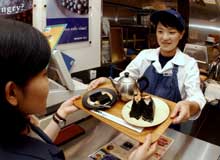 A customer buys onigiri at Ony, a specialty cafe. (Jiji) |
|
GREAT BALLS OF RICE!
Classic Snack Gets New Lease on Life
January 21, 2003
Rice
balls (onigiri) have long been a staple
of Japanese picnics and lunch boxes. Made by wrapping dried seaweed around
a triangular-shaped portion of rice, normally with a pickled plum, piece
of grilled fish, or other filling inside, onigiri
are simple and quick to prepare and perfect for taking on outings. There
is evidence that soldiers of the Heian period (794-1192) used to carry
them, so they have a long history. The triangular shape of most rice balls
has not changed. But recently there have been major changes in consumption
patterns. In the past, onigiri were usually
made at home and eaten by family members, but now they are a top-selling
product in convenience stores, and some cafes have even opened with onigiri
as their signature dish.
Changes Began in the 1970s
The traditional image of the onigiri is of
a bulging clump of rice, perhaps filled with grilled salmon or kelp, that
has been lovingly shaped and wrapped in dried seaweed by a mother. It
was the advent of the convenience store that altered this image decisively.
Right from the start of the convenience-store era in the 1970s onigiri
were one of the stores' key products, and they retain that status today.
The development of packaging that separates the rice from the dried seaweed,
keeping the seaweed crisp, and that allows consumers to do the wrapping
without the rice sticking to their hands, has helped to make store-bought
onigiri popular. So has a wider range of fillings,
some of which add an overseas touch to this venerable Japanese food. Chopped
tuna and mayonnaise, for
example, has been a hit ever since convenience stores began selling rice
balls with this filling. At around ¥100 ($0.83 at ¥120 to the
dollar) each, store-bought onigiri have become
a staple of life.
The Quest for a Superior Rice Ball
The latest development in the rice-ball world has been the appearance
of onigiri cafes. These specialty outlets
are a product of the cafe boom that has been in full swing for several
years and of the general revival of interest in Japanese style. Fashionable
onigiri cafes have been appearing all over
the place. In the Oji area of northern Tokyo, the fast-food chain First-Kitchen
has opened an onigiri eatery called Onigiri
Kitchen Om's, while in the central Tokyo district of Aoyama, Reins International,
the firm that runs the yakiniku (Korean-style
barbecued beef) chain Gyukaku, has launched an onigiri
cafe called Ony.
The options for working women seeking a light meal had previously been
limited to traditional fast-food restaurants or cafes offering little
more variety than sandwiches and spaghetti. Onigiri
cafes have struck a chord with young women and - unusually for fast-food
stores - with middle-aged people, who are often reluctant to enter hamburger
restaurants. The cafes offer a level of service not available in convenience
stores. In some, for example, fresh rice balls are shaped by hand after
the order is taken.
Rice-ball fillings are another area in which the
quest for that something extra is gathering pace. In department-store
basements, whose rich selection of foods make them havens for gastronomes,
onigiri made with only the finest ingredients
are selling well. These deluxe treats are made with top-quality rice transported
direct from where it is grown. Even the water in which the rice is cooked
is specially selected, and luxury fillings like bamboo shoots, aromatic
matsutake mushrooms, and crab deliver a truly
classy taste that differs markedly from that of machine-made onigiri.
Convenience stores, too, are looking to tempt customers with higher quality.
The 7-Eleven chain has launched a new line of gourmet onigiri
that cost around ¥150 ($1.25), a little more than the chain's standard
rice balls, and are handmade using select ingredients. Varieties include
rice cooked with sea bream and charcoal-barbecued mushrooms.
Satisfying Health-Conscious Consumers
Another reason for the recent popularity of rice balls is that they now
appeal not only to people seeking a tasty, convenient snack but also to
the increasing number of consumers who are concerned about health. Many
fast foods, including hamburgers, are cooked using oil, which inevitably
makes them high in calories. The main ingredients in onigiri,
on the other hand, are rice and seaweed. Even if they contain fillings
like meat or mayonnaise, rice balls are modest in size and therefore unlikely
to expand the waistline.
But what may be the most subtle attraction of rice balls is their handmade
feel. The normal fare served up by fast-food chains looks and tastes the
same no matter where you go. But when you have onigiri
prepared just for you or add the seaweed wrapping yourself, you get the
warmth of the personal touch.
|
Copyright (c) 2003 Japan
Information Network. Edited by Japan Echo Inc. based on domestic Japanese
news sources. Articles presented here are offered for reference purposes
and do not necessarily represent the policy or views of the Japanese
Government. |



